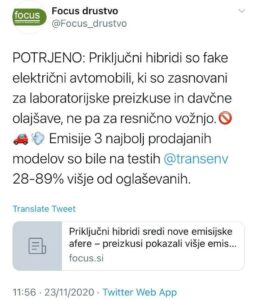On the November 23 2020 Focus Association for Sustainable Development tweeted that: “Tests made by the Transport and Environment campaign group show that emissions of the three bestselling plug-in hybrid cars are 28–89% higher than advertised.” We rate it as true.
In the tweet from the official account of Focus Association for Sustainable Development, the (unknown) manager of the team spoke about how the plug-in hybrids’ emissions of the three best-selling models are at least 28% higher than advertised. Because hybrids are supposed to be eco-friendly, we delved into this tweet to see if that’s actually the case. Namely, the Focus association concretely presented the research, in which it points out advertising based on incorrect data. In a way, they even accuses car manufacturers of their untruthfulness when selling their products. So doubt about this was also our guide for verifying this statement.

A screenshot from the tweet by Focus Association
During our research we have found out that Focus association have been studying climate change solutions since 2003, focusing especially on the energy sector, transport, consumption, global responsibility and equity. Within the framework of these studies, they implemented various national and European projects and activities that they consider a priority in the fight against climate change. That is why they are also members of several international NGO networks, including Transport and Environment campaign group, on which the tweet, that we are checking is based. They have at least eight experts from different fields, and they refer to the research they co-created.
No thinking about charging
Specifically, their tweet is based on the study of plug-in hybrids: Plug-in hybrids: Is Europe heading for a new Dieselgate?. They concluded this report that the BMW X5, Volvo XC60 and Mitsubishi Outlander based on Emissions Analytics company results are tested with 28–89 percent higher CO2 emissions than advertised in a full battery test and under optimal conditions. On all three models, three to eight times higher emissions than the official ones were measured with an empty battery, and when driving in battery charging mode, which could become more frequent due to charging before entering low-emission areas, the emission values were measured at tested plug-in hybrids 3–12 times higher.
“It is easier for car manufacturers to meet EU standards in the field of car CO2 emissions by selling plug-in hybrids, ”as such vehicles currently receive additional benefit,” said Focus association in their response. “If plug-in hybrids are to aid the transition to zero-emission mobility in the 2020’s, urgent changes to EU lays are necessary to make sure that hybrids supplied on the EU market are not just compliance vehicles,” is written in conclusion of the report. Therefore they also point out that it happens that countries subsidize plug-in hybrid electric vehicles (PHEV), which many then buy without even thinking about charging.
Improving situation
Although the research was made independently and with association Transport & Environment (T&E) Society from Brussels, we couldn’t provide the final statement. That’s why we turned to Avto Magazin, one of the largest automotive magazines in Slovenia. Editor-in-Chief Matjaž Korošak presented us some facts about plug-in hybrids and shed some light on the researched statement. His view is that manufacturers have been following the needs of the market and looking for alternatives in technology due to increasingly restrictive legislation.
These hybrids are supposed to be just an intermediate solution, until the way of charging Battery electric vehicles (BEV) and infrastructure is arranged as a solution for those who would like to go on a longer trip, but they do not have this plug-in. These are slightly different models, as they require a different mode of exploitation. If this is not the case, the results will be worse. Charging at home with moderate use, however, would not otherwise pose a major problem. Korošak also points out that until BEV technology is developed enough, the PHEV technology, about which they are talking, is the best solution. It is not ideal, but the situation is improving.
We have also turned to Miloš Milač, an editor of avto.finance.si, to acquire even a greater understanding of the situation. Before turning to talk about the actual fact that we were trying to check, he pointed out that the statement made by Focus Association is “scandalous”. In that, he refers to the obviously different official advertising numbers in numerous different companies and fields not only in the hybrid / electric car industry. Official emissions numbers are lower also for fuel-powered cars, because companies prepare for them good and in optimized conditions. In the same way as laundry detergent official count can say it will do 50 washes, but you might end up doing just 35 or 40 of them. To this, he says: “Is this scandalous? Who will sue those manufacturers?”
Different use of the car
He concludes that the practical numbers can actually be even lower than advertised ones if you drive in the best conditions possible (for example: drive short city distances with charging stations both at work and at home). But as soon as you fall out of that frame you can experience higher numbers. Therefore, numbers might vary depending on the use of the car.
However, the real problem occurs, according to Milač, when we read into the legislation of the EU that deals with hybrid cars. He claims that first the official fuel consumption of hybrid cars is measured and later additionally altered. This is done by taking the official measurements and deliberately reducing them by 44% with the help of the mentioned legislation. This way officially (factory) measured 3.75 l / 100 km of driving (the example of the Mercedes-Benz C 350e) becomes only 2.1 l / / 100 km. Milač concludes that this of course is misleading information and might be the cause in popularity of plug-in hybrids. We have to add thought, that we have tried to check back with Milač and with our own research why such a law exists and how exactly it works, but have been unsuccessful in finding the law or getting an additional response.
Conclusion
We can conclude that the tweet is undoubtedly true. Many researches prove that under certain conditions emissions are higher than actually advertised. However, we have to point out that this is a standard practice in many different companies and fields and it is done under perfect conditions and full optimization of use (of any product). The biggest (and only) lie therefore becomes the EU’s alleged emission “optimization” that gives out false results. However, that does not directly influence the statement we checked, so we rate is as true.
RESEARCH | ARTICLE © Nina Manfreda, Jaka Mikoletič, Marcel Nahtigal, Pia Bedene
Leave your comments, thoughts and suggestions in the box below. Take note: your response is moderated.





